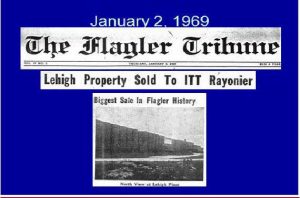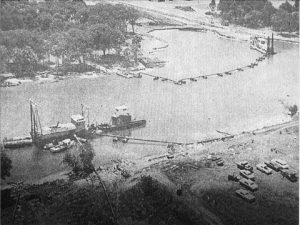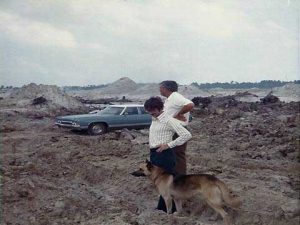By Arthur E. Dycke*
In the belief that Palm Coast residents will enjoy knowing more about their local history, I will attempt to provide a factual and informative narrative of the history of our community. The story thus far may be short but I believe it to be unique and colorful. I will start by presenting a year by year account of the major constructions and events that shaped the growth of Palm Coast from its beginning to the present day. A later series of articles entitled, “Then and Now in Palm Coast” will provide more details and photos of the community’s history.


The 1950’s
In the 1950s Flagler County land that was later to become Palm Coast consisted mostly of unpopulated swamp and pine forest, a few farms, a turpentine distillery, scattered beach houses and an opportunity for outstanding fishing and hunting for fee paying tourists. Most business activity was on state Route 100 from the County seat in Bunnell to the ocean related activities in Flagler Beach. Route A1A took tourists north to Marineland through sparsely populated sandy ocean barrier land. In the West US Route 1 brought northern visitors through endless woodlands to south Florida destinations and a railroad line ran north/south through Bunnell. Occupied land was used for farming, cattle raising, lumbering and turpentine distilling. A large Lehigh cement factory (on what is now Colbert Lane) which was opened in 1952 and closed in 1965 stood empty, its 300 former employees mostly dispersed to other areas.
The 1960’s
1968 – Our Palm Coast community began when the International Telephone and Telegraph Corporation (ITT) bought Levitt and Sons and added it to their ITT conglomerate as a wholly owned subsidiary. The initial planning for our development by ITT/Levitt took place in the fall of that year when a deed for the purchase of the cement plant was recorded in Flagler County on December 23. 1969.


The first public announcement of the sale of the Lehigh property appeared in THE FLAGLER TRIBUNE on January 2, 1969. ITT formed 10 subsidiary companies expressly to purchase land and bought 68,000 acres in Flagler County from 35 landowners, including major owners ITT Rayonier Corporation, Wadsworth Land Company and Lehigh Cement Company. On June 16, the TRIBUNE reported on ITT’s announcement at Princess Place that it would build a 20,000 acre residential complex which would include thousands of waterfront lots, an oceanfront hotel, a golf course and a marina and that they would immediately start construction of the necessary roads, utilities and drainage systems to provide a 500 mile infrastructure. ITT/Levitt offices were established in the old cement plant. Levitt’s project manager Dr. Norman Young predicted a new city in Flagler County that would eventually be populated by 750,000 residents! The purchase included land deeded in 1816 to Gen. Joseph Hernandez who established the St. Joseph plantation and named St. Joe grade (presently Palm Coast Parkway) which, along with Old Kings Road provided entry to our development area. Swamp drainage, tree cutting and site leveling began and a welcome tent was set up near the beginning of construction of a few model homes.
The 1970’s
1970 – Construction of the main canal from the Intracoastal Waterway (ICW) began. A Land Sales Map dated April 7, 1970 is the first document that I could find showing that the ITT/Levitt development had been given the name Palm Coast. Home sites went on the market starting in June. At that time ITT purchased the former Animal Land attraction for use as a local sales office. It was located along highway A1A at the site of the present Board of Education adult education building north of the present Hammock Dunes Bridge. Work commenced on a welcome center surrounded by a model home area. The “first building constructed in Palm Coast” was a 64’ high observation tower which was the centerpiece of the Grand Opening of ITT’s Palm Coast development on October 29. Florida Gov. Claude Kirk was the guest speaker. Tours were conducted by air, water and land during the festive day and the date is recognized today as “Founders Day” for the Palm Coast community. The first issue of the Palm Coaster was published by ITT to keep people informed of the progress of the development. Atlantic Development Corporation was formed under ITT/Levitt to provide water and wastewater service to Palm Coast. Flagler County’s population was 4,454. Palm Coast’s was 0.


1971 – The first 9 holes of the Palm Coast (later Palm Harbor) golf course were constructed and could be seen from the Welcome Center tower in October 1970. The course officially opened to the public on September 14, 1971. The number of home site purchasers more than tripled from 2,500 to more than 8,000. Residential home construction began on the corner of Club House and Casper Drives (the Drive, the latter being the first road built in Palm Coast. The US Justice Department forced the ITT Corporation to divest itself of Levitt and Sons because of antitrust concerns. The ITT Community Development Corporation (ICDC) was formed to develop Palm Coast. Flagler County adopted its first subdivision regulations.


1972 – The first Palm Coast residents (“Pioneers”) moved into their home in the “C” section on January 21. ICDC opened the Palm Coast Yacht Club (present day Palm Coast Resort) featuring the Harbour Restaurant on December 15 to be the religious, civic and social center of the community. The facility included a marina, launching ramp, pool and tennis courts. ICDC created the Atlantic water management District to tax residents for drainage maintenance in Palm Coast. The district was nullified by a court following a lawsuit filed by bordering property owners. Residents formed a Civic Association and population in the developments numbered just over 200 by the end of the year.


